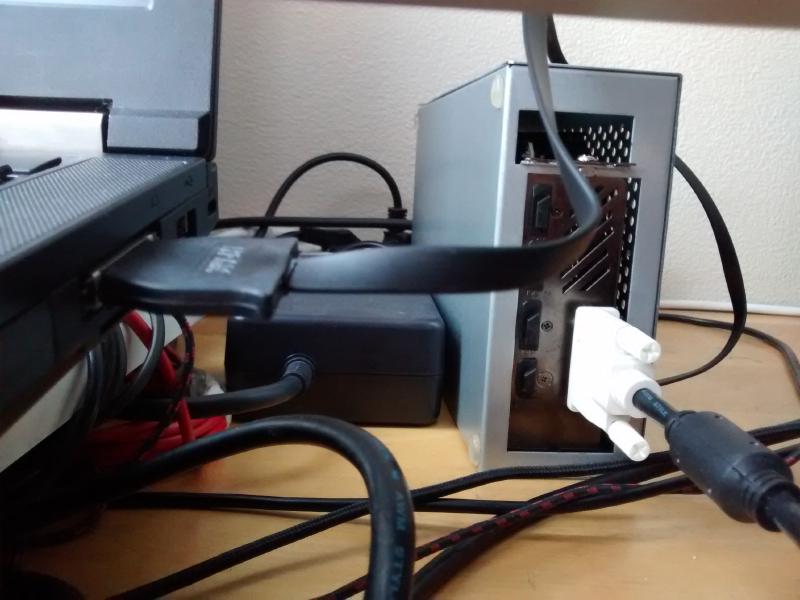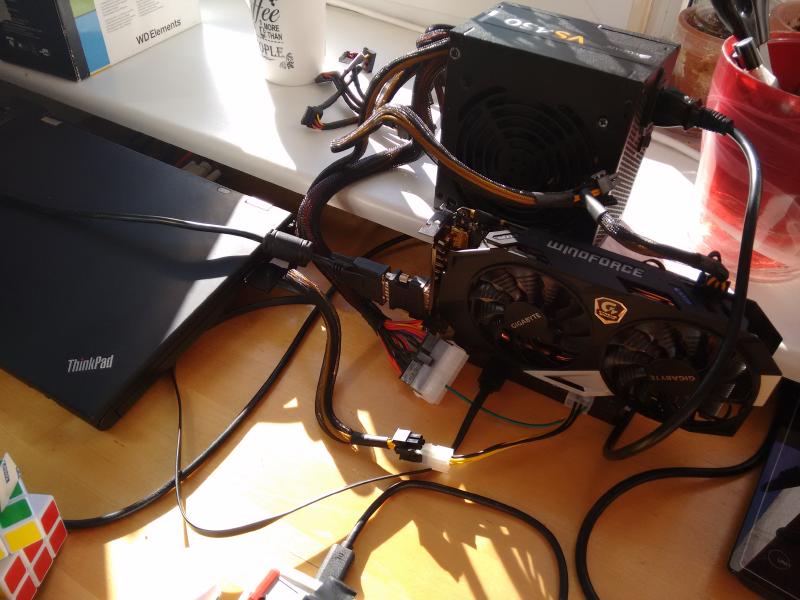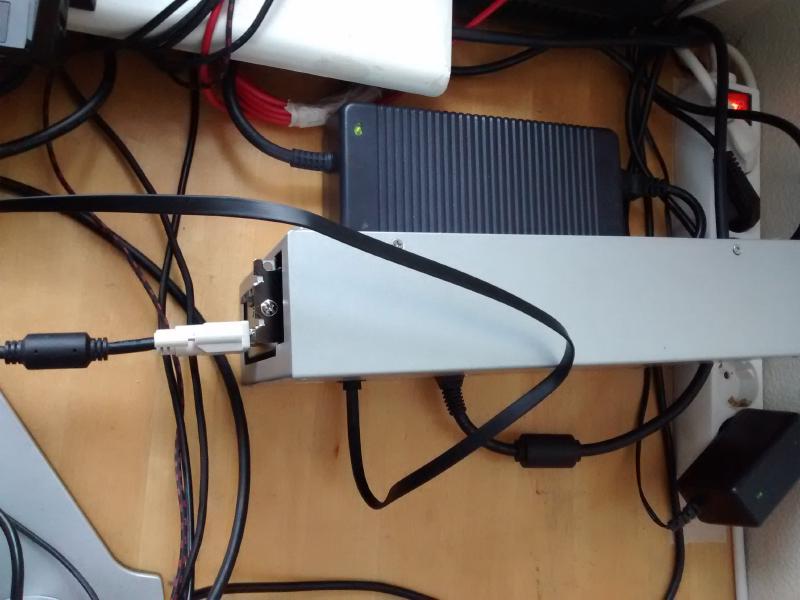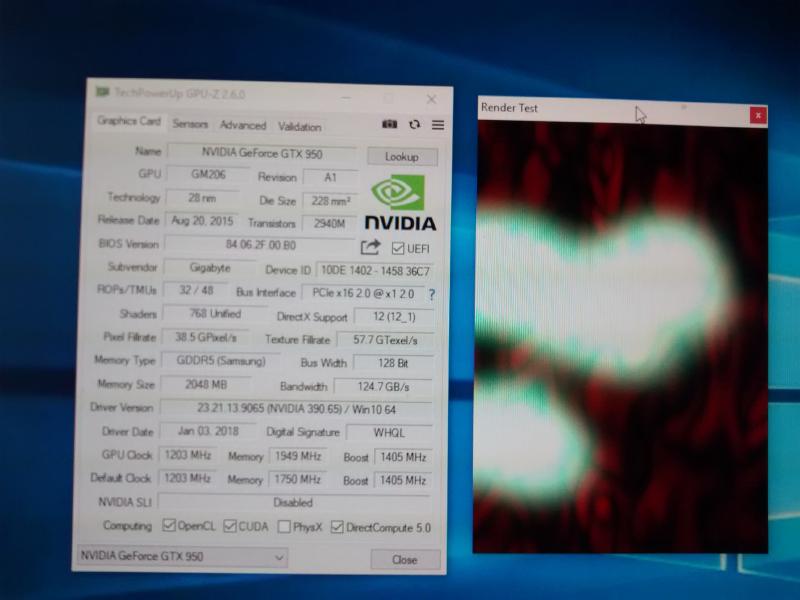About the time my ThinkPad T430 ran with an external GPU

The ThinkPad T430 is not a remarkable laptop. It’s thick, bulky and built like a tank. I got mine in 2016 when the first university scholarship money dropped, and it’s still my backup laptop of choice.
Around 2017 I did something every reasonable poor computer science student would do: I got an eGPU adapter for it to play some games. I never ended up playing many games, but I loved tinkering with and testing this setup a lot.
These are my notes on the setup that I used to have. The notes used to be on Reddit, but after yet another user-hostile change1 I deleted my account and all the content associated with it.
The specs
The ThinkPad T430 that I used had a CPU swap at one point, running an Intel i7-3820QM. This upgrade doubled the CPU performance on the laptop compared to the dual-core CPU that was in it before. This change was critical because it opened the door to running lots of modern games at reasonable performance.
The eGPU adapter I ran with was the EXP GDC Beast v8.4, using the ExpressCard34 connector. This adapter turned the ExpressCard34 slot into a PCIe 2.0 x1 slot. It’s not really hotpluggable, but using this connector instead of something like the internal Wi-Fi adapter slot made this setup much more portable. Done gaming? Shut down, disconnect the ExpressCard cable and you’re good to go!
This adapter is also a good example of connector reuse. The other end of the ExpressCard plug is an HDMI port. Video signals require good quality cables, and so does PCI Express.

The eGPU was once powered by a simple ATX PSU with the jumper wire set on the 24-pin connector, but eventually I bought a Dell DA-2 power supply. The adapter has a power connector designed specifically for that pinout and it made the setup a lot cleaner.


At one point I got a fully metal case for the eGPU. It made the setup a lot cleaner and the risk of the GPU tipping over while turned on was also substantially reduced.

I tested a few GPU-s:
- AMD Radeon HD 6870
- nVidia GTX 950
- nVidia GTX 1080
- AMD Radeon RX 480
The HD 6870 was an old card back in 2017, and it did not run great at all with this eGPU adapter. It was buggy and the performance sucked.
Loaner GPU-s, such as the RX 480 and GTX 1080 were much better experiences, as long as you output the video signal to an external display right from the GPU.
The nVidia GTX 950 was the card I ran with for the longest time in this setup. It worked well with this setup and had decent gaming performance.


eGPU tech tips
You will want to use an eGPU adapter with an external monitor for the best performance. The PCIe bandwidth is very limited in a setup like this. Using the internal display of the laptop will mean that the final rendered image will have to be sent back from the eGPU to the CPU. 1x PCIe 2.0 lane is about 500 MB/s of bandwidth. Sending 60+ frames in the native resolution (1600x900) will eat it all up. The higher the resolution on the internal display, the fewer frames you’ll get.
I tested out these two scenarios in CSGO. The internal display yielded about 61 FPS while an external display would result in 100-180+ FPS.
The PCIe link bandwidth was not actually that noticeable in a lot of games, such as GTA V, Rocket League and Dirt 3.
In some games, such as Dirt Rally (2015), it did not matter what settings you went with, something about the game made it run poorly no matter what graphics settings you went with. In cases like that you might as well cap the framerate to something tolerable like 30 FPS and crank the graphics settings up.
VFIO on a laptop???
This setup was also around the time when I first learned about the magical world of VFIO and GPU passthrough.
The logical continuation of that discovery was to try it out on my laptop, and to my surprise it actually worked. I could pass the eGPU to a VM and play GTA V on it!
This setup ran on Antergos OS, a flavor of Arch Linux. It’s been so long since then that the flavor of Arch Linux is now discontinued.2

The laptop was ideal for this purpose as well. You have the integrated GPU, display, keyboard and mouse for the host system, and you can pass USB devices and the eGPU to the VM.
There were the usual VFIO tricks that I had to try out to avoid the dreaded
error code 43 issue, but after that it was smooth sailing.
The performance was very similar to what I saw on the host system.
Here’s a clip of me recording this setup while playing GTA V. Smartphone cameras have come a long way since then.
ExpressCard eGPU-s in 2024?
What got me started with writing down my notes were some YouTube videos that were made on this topic recently.
A pimped-out ThinkPad T430 can still be a perfectly serviceable computer in 2024, and an eGPU will completely sidestep the problem of the weak integrated GPU.
The T430 is not powerful enough to natively run a 3440x1440 ultrawide monitor at 60 Hz. It is even struggling to do it at 30 Hz. An eGPU adapter with a modern low-power GPU, such as the AMD Radeon RX 6400, could solve this issue nicely and give the ThinkPad T430 a new lease of life.
I’d be lying if I wasn’t considering remaking this setup with everything I’ve learned 6 years later. GPU pricing sucks, though.3 They still sell these eGPU kits in various forms, however the price has doubled or even tripled over the years.
If you’re interested in building a similar setup, then do check out egpu.io. With an M.2 or Thunderbolt connector you can build a much more capable eGPU setup.
If you can get a PCI Express signal out of a computer, then you can probably rig a GPU up to it. Unless you’re Jeff Geerling, in which case you might need to recompile the kernel a few times.
Subscribe to new posts via the RSS feed.
Not sure what RSS is, or how to get started? Check this guide!
You can reach me via e-mail or LinkedIn.
If you liked this post, consider sharing it!